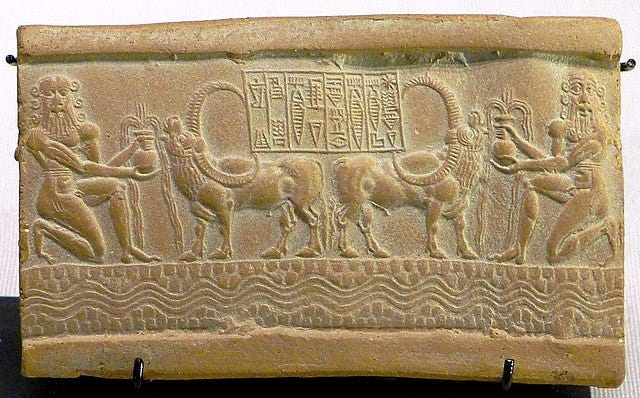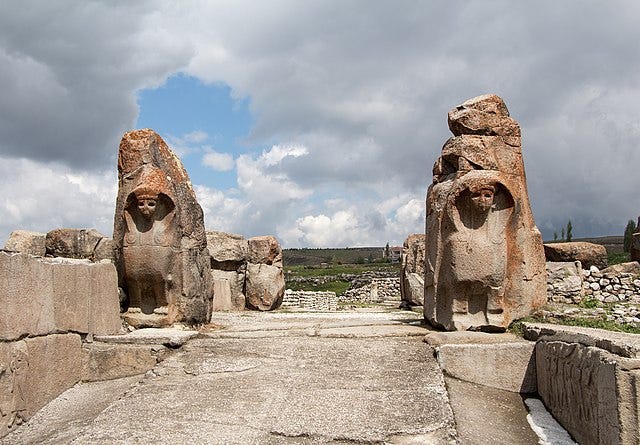I'm finally back.
Sorry for the week delay.
On a positive note, my cold is finally gone.
Today I’m sharing my thoughts on the seventh fortnight of our adapted version of Ted Gioia’s Course in Humanities.
You can find previous parts of this course at the end of this post.
For now, we’ll discuss:
a) Ancient Mesopotamian art.
b) Stravinsky: The Rite of Spring and Wagner’s overtures.
c) The Epic of Gilgamesh and Dhammapada.
Ancient Mesopotamian art
The area known as Mesopotamia (between the rivers Tigris and Euphrates) has been occupied long before Homo sapiens left Africa. Several archeological sites have been discovered, attesting the existence of multiple peoples and cultures throughout millennia.
However, when we talk about Mesopotamia or the Near East, the first thing that comes to mind tends to be the birth of civilization. The people who lived there invented writing1 (which is probably the coolest or at least second coolest thing ever created by our species), the wheel (also revolutionary and maybe the number one spot in a lot of lists, but not mine), cities, agriculture, law, mathematics, astronomy (and astrology), medicine and so much more you could write thousands of volumes and fill entire libraries (which they did).
Specifically on the matter of art, the next civilization to dominate the area (and there were many) usually built upon what the previous one left behind.
Starting with the Sumerians (c. 3400-2000 BCE), by no means the first to live and produce art in Mesopotamia, but famous for the marvelous creations, we can highlight pottery, metalwork, sculpture and even leisure items, like musical instruments and games.
The grave of a high-ranking woman called Pu-abi, in the Royal Cemetery of Ur, is the source of many jaw dropping findings, like this lyre:

Then came the Akkadians (c.2500-1790 BCE).
You might have heard of of King Sargon, who united Mesopotamia under his rule and became the world’s first emperor, or his daughter, Enheduanna, the first author2 we know of.
After conquering the Sumerians, the Akkadians kept a lot of their culture and religion alive, absorbing and futher developing them. The best known pieces of art they left behind are probably their sculptures, steles and (impressions of) cylinder seals.

It’s also worth mentioning the Hittites (c. 2000-1000 BCE). Originally from modern-day Turkey, their reach spread through most of Asia Minor during their Imperial period. Most of what we have left of them consists of metalwork and stone reliefs, which were a distinctive feature of the architecture, particularly their gateways.
The Assyrians (c. 1500-612 BCE) are known for relif carving, sculpture and fine ivory carvings on plaques (especially on their furniture). Representations of lions or the lion hunt, which had religious and political significance, were very common.
The Babylonians (c. 1800-1595 BCE) and Neo-Babylonians (c.1150-539 BCE) had a knack for making animal reliefs on glazed, polychrome bricks, among other things.
We also can’t forget about the Persians, who were defeated by Alexander, the Great, and the list goes on and on until we get to modern-day Iraq.
All of these civilizations were highly influential and helped shape both East and West.
Music
The Rite of Spring (Le Sacre du Printemps) is a ballet first performed in 1913 by Diaghilev's Ballets Russes at the Theatre du Champs-Élysées in Paris.
The set and costumes were designed by Nikolai Rerich (1874-1947), the original performance was choreographed by Vaslav Nijinsky (1889-1950) and the music was composed by Igor Stravinsky (1882-1971). In 1920 the ballet was put together again and Leonid Myasin (1896-1979) was in charge of the new choreography (the original had been lost).
Stravinsky wanted to create a score about russian people from ancient times, celebrating a fertility rite in hopes of achieving a successful harvest through the sacrifice of a young girl, who dances to the god of spring until she dies.
You might have heard it in Disney’s Fantasia. It’s worth noting that particular section of animation is about life in prehistoric times, not spring (unless you consider that period as spring in the grand scheme of things).
The piece is good, but not my cup of tea. When it comes to classical music and ballet, I’m more of a Romantic kind of girl.
I enjoyed Wagner’s overtures (and preludes) a bit more.
Wilhelm Richard Wagner (1813-1883) was German composer, theatre director, essayist, and conductor best known for his “music dramas” (and his controversial, scandalous life).
He was highly involved in his operas, writing both the libretto (he called his lyrics “poems”) and the music. He wanted to combine poetic, visual, musical and dramatic arts, presenting a continuous narrative through song. His most famous work is tthe four-opera cycle The Ring of the Nibelung (Der Ring des Nibelungen). He is considered an important bridge between Romantic and Modern music.
Dhammapada
The Dhammapada is a collection of sayings of the Buddha in verse form (423 stanzas arranged in 26 chapters) and one of the most widely read, translated and known religious scriptures. It is an anthology of basic Buddhist teachings, primarily ethical and metaphysical in nature, in aphoristic style.
I personally didn't get much out of it.
Truth be told, apart from some specific terminology (Buddha, Māra, etc.), I found it incredibly generic, which might be a testament of how influential the text was or a sign there is some shared cultural background behind these aforisms I'm not aware of.
Still, it was worth reading.
The Epic of Gilgamesh
The Epic of Gilgamesh is actually called He who Saw the Deep(s) (the first line of the poem), in the version compiled by Sîn-lēqi-unninni.
The story originated in ancient Mesopotamia, with five Sumerian poems about Bilgames, later called Gilgamesh, king of Uruk, presumed to have lived c. 2700 BCE. The oldest writings about him are dated c. 2100 BCE, so there's a chance he is purely mythological, though many scholars believe he was a real man deified after death through legends.
An epic poem about him was written in Akkadian, based on Sumerian tablets. There are a few versions of it, but the most famous is the Standard Babylonian text by Sîn-lēqi-unninni (around 13th BCE).
The poem follows the story of king Gilgamesh (two-thirds god, one-third human) and his adventures with his friend/lover3 Enkidu, made out of clay by the gods especially for him. They slay the Guardian of the Cedar Forest, Humbaba, insult the goddess Ishtar and kill the Bull of Heaven (constellation taurus).
Enkidu is punished with death and a grieving Gilgamesh goes on a dangerous journey trying to find Utnapishtim, who survived the Flood with his wife and was granted immortality by the gods, and ask him how to live forever. Eventually, he learns to accept dying as part of being human and goes back home a wiser man.
Though a big hit in ancient times, the text was “lost” when cuneiform writing was abandoned (around 1 CE) and rediscovered in the 19th century.
However, just because we weren't aware of its existence, doesn’t mean Gilgamesh’s story was truly lost.
The Western world was mostly built upon Christianism, which literally came from the Near East, and Roman-greek culture, which was highly influenced by Asia.
While reading the poem, you might be shocked at how familiar the story is — the similarities to the Bible and Greek literature are astounding.
In case you don’t know, Akkadians, Phoenicians4, Jews, Arabs and other groups from what we now call the Middle-east are Semitic peoples, belonging to the same language family. As such, they share many myths, sayings, practices, etc.
The story of the Flood/Ark and people made out of clay, already ancient in the 6th century BCE5, probably made their way to the Torah when the Jews were living under Babylon.
The parallelism and chiasmus, common in many semitic poetry, including hebrew; the power of words one can’t take back (blessing and curses); popular/proverbial sayings6; the typical structure of funeral hymns or lamentations; making a stele or putting a foundation stone in temples are just some of the ways the Judeo-christian mythology can be traced back to older Mesopotamian tradition and belifs.
The Greeks, intrinsically connected to the East due to trade and exploits in the Mediterranean Sea, also picked up a lot from the peoples of Mesopotamia. Besides the alphabet, I could mention the archetypal hero7, the symbolism of everyday things (doors, chariots, stars, etc.), myths8, Ringkomposition, among other things one would have to write a book (several books?) to cover.
If I were to create my own humanities course, I would start with Mesopotamian literature, followed by Greek poetry and the Bible. Seriously, give it a try and you'll see what I’m talking about.
I loved Epic of Gilgamesh and I couldn't have picked a better edition (I strongly recommend it to anyone who can read Portuguese).
Translated from the akkadian and annotated by Professor Jacyntho Lins Brandão9, the text is accessible, fluid and rich. The commentary is on point, introducing the reader to the story of the text itself, the Sumerian-akkadian cultural background and the poem’s idiosyncrasies. It also does a great job at emphasizing (and sometimes theorizing) the connections between that epic and us.
I liked his work so much I already have two more of his annotated translations of Mesopotamian literature ready to go. I was thoroughly pleased to find out my money was used to support his work (the university where he teaches is funded by taxes) and I plan to keep buying his books.
If I read at least one book I love as much as this one every month, this is will be the best reading year of my life.
Sneezing, coughing and pain aside, 2025 is off to a great start.
This is it for today.
I hope you’ll join me for next fortnight.
In case you haven't read them, here are parts One, Two, Three, Four, Five and Six.
Other than the Sumerians, three civilizations are credited with inventing ex nihilo (from nothing) writing systems: Egyptian (also in the 4th millennium BCE, but a little later than Sumerian cuneiform writing), Chinese (2nd millennium BCE) and Mesoamerican (1st millennium BCE). Out of those four writing systems, the only one to stand the test of time, albeit with many changes and adaptations, is the Chinese, probably because their culture and language survived.
As in the very first person whose existence we can verify and associate to original writing, which is impressive considering she lived in the 23rd century BCE. For the sake of comparison, we have no evidence Homer, the author of the Iliad and the Odyssey, actually existed and he is believed to have lived around the 8th century BCE. Enheduanna was a priestess and it is presumed she wrote many hymns.
For a long time scholars debated whether their relationship was sexual, but it seems pretty clear to me it was.
The Phoenician alphabet was most likely adopted (and later adapted) by the Greeks during the early 8th century BCE.
Around the time the oldest biblical texts were written.
For example, a threefold cord beeing difficult to break appears in both the Epic of Gilgamesh (T. V, V. 79) and Ecclesiastes (C. 4, V. 12).
Gilgamesh is practically a prototype for demigods trying to prove themselves and obtain glory.
Check out Deucalion and Pyrrha’s story.
Published by Autêntica Editora Ltda.






